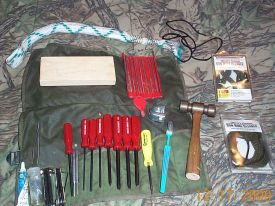Weapon selection:
There has been stuff written all over the place about what weapon to get, so I wont go into it, but to say just about any military weapon is a good choice. They have great schematics. But some commercial models have good schematics as well.
Relatively few malfunctions are caused by broken parts. Most malfunctions are caused by lube, dirt, carbon build up or bad ammo. Knowing how your weapon functions will greatly enhance your ability to find the source of trouble.
Tools:
The tools to fix most firearms are basic; there will be some special tools if you do use a military weapon like a combo wrench. For the AR-15 for example. Most important is some gunsmith screwdrivers, with parallel ground bits. Next to screwdrivers is a good set of pin punches. Then about an 8-oz. brass hammer (brass won't dent or mar the finish on your weapon). Also a good cleaning rod with brushes, slotted tip and a case remover (this will help remove broken cases stuck in the chamber). Donít forget a good pair of multi-pliers, like a Gerber or leatherman.
Other tools that are a good idea but are only optional are: a dental scalar, set of small files (flat and round), an India stone med. grit, set of Allen wrenches, tooth brush, tweezers, loctight, a piece of hard wood (to use as a hard surface) plus any sighting tools you may need for your weapon.
Spare Parts:
I would suggest a spare firing pin or striker, extractor, ejector and any springs and pins for these parts. Also add anything you know from the past that your weapon uses or breaks. For example, I had a Savage 110 that I broke the extractor on twice so I would add those parts.
Now is the to insure that your weapon will function when you need it. Ruggedness, reliability, availability of ammo and spare parts with the ease of repair is factors to consider. Obtain the manuals and spare parts with tools, to insure that you can find and repair any problems in the field.
Here is a picture of the gunsmith tools that live in my pack.
 | From the top: A pull through cleaning kit for shotguns, Block of hard wood, set of small files, Pull through cleaning kit for 30. cals. sight adjusting tools for AK/SKS rifles (windage tool I got from the Alpha main board about a year ago, A pair of small tweezers (for holding small pins and springs, Small tube semi per. loctight, Two Allen wrench sets, one small Allen wrench for a scope I have), screw drivers, two pin punches, one hole punch ( used to take apart the SKS if in one of the synthetic stocks), tooth brush, 8-oz. brass hammer and a pull through cleaning kit for 9mm./38./357. My pliers are on my belt and the real cleaning kit is in my pack. The pull through kits are for daily cleaning. The real kit is for everything else, including the bi-weekly cleanings (when in the field). |
Taurus
Address:

All materials at this site not otherwise credited are Copyright © 1996 - 2001 Trip Williams. All rights reserved. May be reproduced for personal use only. Use of any material contained herein is subject to stated terms or written permission.